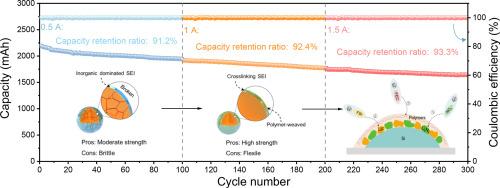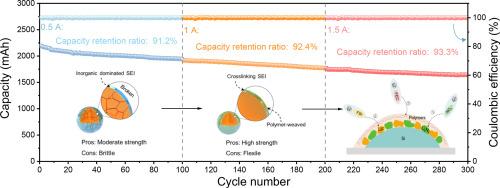Rectifying solid electrolyte interphase structure for stable multi-dimensional silicon anodes
IF 18.9
1区 材料科学
Q1 CHEMISTRY, PHYSICAL
引用次数: 0
Abstract
Electrolyte engineering is a promising strategy to stabilize electrode structure. However, the high active material utilization of Si anode accompanied by inevitable huge volume expansion makes higher requirements than regulating Li metal deposition behaviors from dendrite growth. Herein, we rectified the solid electrolyte interphase (SEI) layer on Si surface to maintain the electrode integrity during repeated cycling. In our design, an oligomeric buffer layer (CHO2-/CH3O-) derived from FEC and an inorganic pillar (LiF/Li3N) derived from LiFSI/LiNO3 weave into organic-inorganic crosslinking SEI during the initial activation process. Leveraging COMSOL modeling reveals the small stress and strain of the Si particle under the protective effect of concrete SEI layers. Moreover, synchrotron X-ray 3D nano-computed tomography comprehensively elucidates the structural integrity of Si particles during cycling. With this merit, various silicon-based anodes show remarkable cycling stability. Notably, the Si/C || LiFePO4 full battery still affords a capacity retention ratio exceeding 95 % at 1 mA cm−2 after 300 cycles. This interphase engineering design strategy provided in our work advances the understanding of how to cope with devastating volume variation by leveraging the SEI characteristic perspective.


用于稳定多维硅阳极的整流固体电解质相间结构
电解质工程是稳定电极结构的一种可行策略。然而,硅阳极的高活性材料利用率伴随着不可避免的巨大体积膨胀,这就对调节枝晶生长的锂金属沉积行为提出了更高的要求。在此,我们对硅表面的固体电解质相间层(SEI)进行了整流,以在反复循环过程中保持电极的完整性。在我们的设计中,源自 FEC 的低聚缓冲层(CHO2-/CH3O-)和源自 LiFSI/LiNO3 的无机支柱(LiF/Li3N)在初始活化过程中交织成有机-无机交联 SEI。利用 COMSOL 建模揭示了硅粒子在混凝土 SEI 层保护作用下的微小应力和应变。此外,同步辐射 X 射线三维纳米计算机断层扫描全面阐明了硅颗粒在循环过程中的结构完整性。凭借这一优点,各种硅基阳极都表现出了显著的循环稳定性。值得注意的是,Si/C || LiFePO4 全电池在 1 mA cm-2 循环 300 次后,容量保持率仍超过 95%。我们工作中提供的这种相间工程设计方案,有助于人们理解如何利用 SEI 特性来应对破坏性的体积变化。
本文章由计算机程序翻译,如有差异,请以英文原文为准。
求助全文
约1分钟内获得全文
求助全文
来源期刊

Energy Storage Materials
Materials Science-General Materials Science
CiteScore
33.00
自引率
5.90%
发文量
652
审稿时长
27 days
期刊介绍:
Energy Storage Materials is a global interdisciplinary journal dedicated to sharing scientific and technological advancements in materials and devices for advanced energy storage and related energy conversion, such as in metal-O2 batteries. The journal features comprehensive research articles, including full papers and short communications, as well as authoritative feature articles and reviews by leading experts in the field.
Energy Storage Materials covers a wide range of topics, including the synthesis, fabrication, structure, properties, performance, and technological applications of energy storage materials. Additionally, the journal explores strategies, policies, and developments in the field of energy storage materials and devices for sustainable energy.
Published papers are selected based on their scientific and technological significance, their ability to provide valuable new knowledge, and their relevance to the international research community.
 求助内容:
求助内容: 应助结果提醒方式:
应助结果提醒方式:


